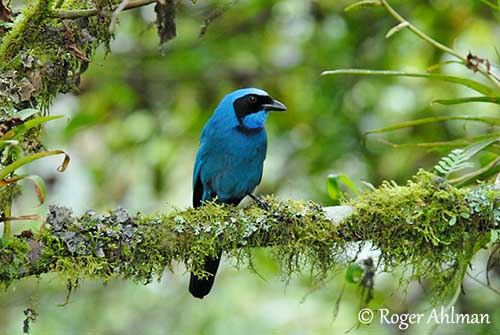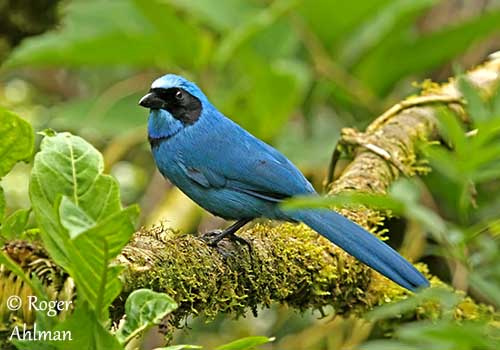
Fr: Geai turquoise
Ang: Turquoise Jay
All: Türkishäher
Esp: Chara Turquesa - Urraca Turquesa - Urraquita turquesa
Ita: Ghiandaia turchese
Nd: Turkooisgaai
Sd: Turkosskrika
Photographer:
Roger Ahlman
Pbase Galleries Peru and Ecuador
Text by Nicole Bouglouan
Sources :
HANDBOOK OF THE BIRDS OF THE WORLD Vol 14 by Josep del Hoyo-Andrew Elliot-David Christie - Lynx Edicions – ISBN: 9788496553507
A GUIDE TO THE BIRDS OF COLOMBIA by Steven L. Hilty and William L. Brown - Princeton University Press – ISBN 069108372X
BirdLife International (BirdLife International)
Neotropical Birds – Cornell Lab of Ornithology
Wikipedia, the free encyclopaedia
Below, comparison with a close species, the Beautiful Jay (Cyanolyca pulchra)
ORNITOLOGIA NEOTROPICAL 21: 611–614, 2010 - © The Neotropical Ornithological Society
PARENTAL CARE AND NESTLING DEVELOPMENT OF THE BEAUTIFUL JAY (CYANOLYCA PULCHRA) IN NORTH WESTERN ECUADOR
By David A. Laufenberg & Catherine Woodward
Turquoise Jay
Cyanolyca turcosa
Passeriformes Order – Corvidae Family
INTRODUCTION:
The genus Cyanolyca includes small and sleek jays with blue to turquoise plumage and conspicuous black mask and collar.
The Turquoise Jay is found in humid montane evergreen forests on both sides of the Andes in S Colombia, Ecuador and N Peru. This species can be seen at high elevation.
DESCRIPTION OF THE BIRD:
Biometrics:
Length: 30-32 cm
The adult has mostly turquoise blue to cerulean blue plumage. Head, nape and throat are paler, becoming whitish towards the forehead and mostly light milky blue on throat. Forehead, lores and head sides are black and form a conspicuous mask that continues down the neck sides, ending in narrow black collar between lower throat and upper breast. Rest of plumage is cerulean blue, except the blackish underwing and undertail.
The strong bill is black. The eyes are dark brown. Legs and feet are black.
Both adults are similar.
The juvenile is probably duller.

RANGE:
The Turquoise Jay is found in both slopes of the Andes from S Colombia, Ecuador and NW Peru. In Colombia, it is resent in Nariño, and probably N to Parque Nacional Puracé in Cauca. In C Ecuador, it occurs on both slopes of the Andes. In N Peru, it is found in Piura and Cajamarca.
HABITAT:
The Turquoise Jay frequents humid forest and forest edge up into montane rain forest at treeline. It can be found in both primary and secondary growth. It frequents the tall montane evergreen forests and the shorter elfin woods with thick tangled trees and shrubs, and abundance of epiphytic plants such as Bromeliaceae, Araceae and mosses.
CALLS AND SONGS: SOUNDS BY XENO-CANTO
The Turquoise Jay frequently produces a loud “tsrrrp” and an explosive “kworr” often repeated 3-4 times. It also utters short sounds such as a clicked snapping sound. They give contact calls while foraging in small flocks and between mates.
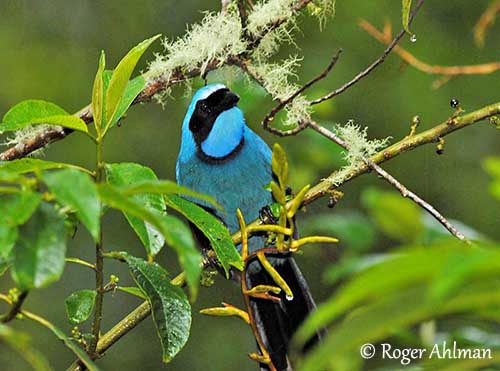
BEHAVIOUR IN THE WILD:
The Turquoise Jay is omnivorous like numerous Corvidae species. It probably feeds mainly on insects such as Coleoptera, Lepidoptera and Orthoptera, but it also takes berries. It visits the nests of other bird species, and takes both eggs and hatchlings.
It usually forages in small flocks of 2-6 individuals at different levels including canopy and subcanopy. While foraging, it hops along the branches while searching for preys in epiphytes, stopping sometimes to peer through the vegetation.
The Turquoise Jay rarely perches in open for long time. It usually remains in high trees, venturing sometimes into bushes near settlements.
There is no information about the courtship behaviour of this species, but usually, the Corvidae tend to be monogamous with strong pair-bond sustained during the year and often during the life.
Courtship displays are unknown, but the “up-fluffing” of the plumage is commonly seen in Neotropical jays. During this display, the bird extends the neck and slowly erects the feathers of head and neck. The Turquoise Jay probably uses its beautiful plumage and head pattern during displays, by adopting postures that enhance the blue plumage and the black mask. They often become more aggressive during the breeding season.
The Turquoise Jay is sedentary in its range.
The flight is agile and powerful.
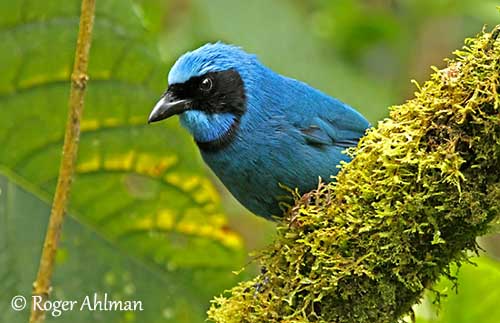
REPRODUCTION OF THIS SPECIES:
There is little information on the breeding behaviour of this species.
From observations of three nests (H.F. Greeney – 24 February 2010), the large nests are made mainly with moss and placed in forks of small branches, usually high in isolated trees, between 9 and 16 metres above the ground.
There were three adults at each nest-site, and all the three adults were taking part on nest building at one site. This observation suggests co-operative breeding which seems to be frequent among the Neotropical jays.
The breeding season is probably related to the rainfall. The resident birds usually attempt to nest before the rain and continue afterwards. Food availability is also important, especially insects, for feeding the chicks.
From another observation of the related species the Beautiful Jay (C. pulchra) which shares many attributes of nesting behaviour with other Cyanolyca species, the chicks hatch on mid-April and are fed by the adults, mainly on insects. Two chicks were reared and fledged 15 days after hatching (20 days in C. cucullata). The Beautiful Jay occurs on the Pacific slope of the Andes in Colombia and N Ecuador, and its range overlaps with that of the Turquoise Jay.
The nests can be sometimes parasitized by the Giant Cowbird (Molothrus oryzivorus).
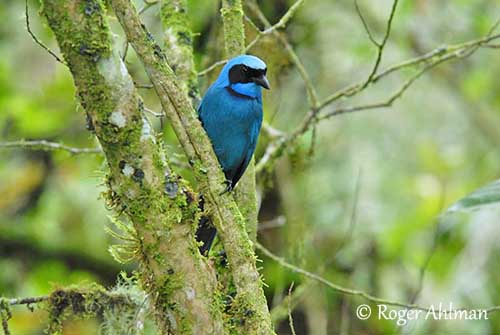
PROTECTION / THREATS / STATUS:
The Turquoise Jay is fairly common in Ecuador and Peru and less common in Colombia. This species has relatively large range in South America, and its population is suspected to be stable, but the size has not been quantified.
The Turquoise Jay is currently evaluated as Least Concern.
